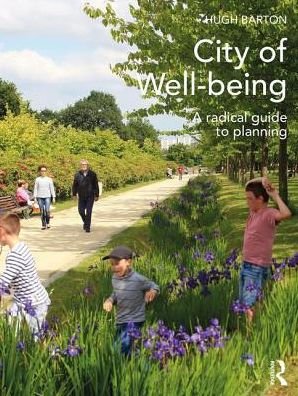City of Well-being: A radical guide to planning / Edition 1 available in Hardcover, Paperback, eBook

City of Well-being: A radical guide to planning / Edition 1
- ISBN-10:
- 0415639328
- ISBN-13:
- 9780415639323
- Pub. Date:
- 11/21/2016
- Publisher:
- Taylor & Francis
- ISBN-10:
- 0415639328
- ISBN-13:
- 9780415639323
- Pub. Date:
- 11/21/2016
- Publisher:
- Taylor & Francis

City of Well-being: A radical guide to planning / Edition 1
Buy New
$240.00Overview
The science. Summarizing the most recent research, the book demonstrates the interrelationships between the huge issues of obesity, unhealthy lifestyles, inequality, mental illness, climate change and environmental quality. The radical implications for transport, housing, economic, social and energy policies are spelt out.
The art and politics. The book examines how economic development really happens, and how spatial decisions reinforce or undermine good intentions. It searches for the creative strategies, urban forms and neighbourhood designs that can marry the ideal with the real. The relationship of planning and politics is tackled head-on, leading to conclusions about the role of planners, communities and development agencies in a pluralistic society. Healthy planning principles could provide a powerful logical motivation for all practitioners.

Product Details
| ISBN-13: | 9780415639323 |
|---|---|
| Publisher: | Taylor & Francis |
| Publication date: | 11/21/2016 |
| Pages: | 304 |
| Product dimensions: | 7.44(w) x 9.69(h) x (d) |
About the Author
Table of Contents
Contents
List of Figures
Preface
Acknowledgements
I Orientation
Prologue: contrasting city scenarios
1. Putting people at the heart of planning
- Introduction: the purpose of planning
- Time-bombs of health, climate and urbanization
- Planning at the cross-roads
- Reflection
2. A framework for understanding
- Towards an eco-system model of cities
- The settlement health map
- Interpretation of the health map
- Conclusion: ethics for planners
II Inspiration
3. Shafts of light from the past
- Classical designers and the city of Priene
- The Mediaeval city: Siena
- Grand designs: Paris re-imagined
- Ethical entrepreneurs and Saltaire
4. The emergence of modern planning
- The public health revolution
- Ebenezer Howard and Garden Cities
- The pioneers in Britain and America
- Planning as civic design
- The British new towns
- Gaining the country but losing the plot
5. Beacons of hope
- Introduction: Healthy Cities
- Copenhagen: city of cyclists
- Kuopio: city of lakes and forests
- Freiburg: city of short distances
- Portland: breaking the neo-liberal taboo
- Lessons from inspirational cities
III Cognition: understanding people and environment
6. Spatial planning for physical well-being
- Obesity, health and physical activity
- Active travel – walking and cycling
- Active recreation
- Healthy diet
- Cautions and counsels
7. Planning for mental and social well-being
- Nature, greenspace, sun and sound
- Social networks and community
- Healthy, diverse neighbourhoods
- Social capital and empowerment
- Spatial planning recommendations
8. Planning for place equity
- Social justice and health inequalities
- Planning for all
- Work, income and spatial policy
- Housing and living conditions
- Movement and accessibility
9. Climate change and settlement planning
- The science of climate change
- Greenhouse gases, energy and planning
- Sustainable energy strategy
- Human ecology
10. The local ecology of cities
- Ecological resilience
- Green infrastructure
- Air quality and planning
- Sustainable urban water systems
- Biodiversity
- Local food production
IV Navigation: a route map for healthy planning
- Criteria for judging healthy urban policy
11. Reality check: the economics of land and development
- The life-cycle of a plot
- Players in the development game
- Land and housing markets
- How land values shape the city
- Urban renewal and managing the market
12. Sustainable urban form
- Understanding urban form
- Centrifugal and centripetal forces
- Decentralization versus the compact city
- Polycentricity and linearity
- Five key urban form decision areas
13. Healthy neighbourhood design
- Introduction: the significance of locality
- The shape of neighbourhoods
- Spatial analysis and density
- The quality of place
- Conclusion: urban design
14. Urban dynamics
- Introduction: strategic planning issues
- Understanding the economic base of a city
- Population and housing
- Matching economic activity and population
- Transport infrastructure and economic development
V. Perspiration: land, power and the planning process
14. The governance of land
- Is planning really necessary?
- Private and community property rights
- Comparative planning systems
- Local government powers
- Conclusion
16. The planning process and the role of planners
- Dimensions of planning: technical, political and executive
- From design to the rational planning process
- Heroic versus humdrum planning
- The medium is the message: collaborative planning
- Testing theory against practice
- Ethical planning
17. Putting principle into practice
- Making decisions in a pluralist society: engaging communities
- A cyclic planning process
- Case study: Stroud town centre Neighbourhood Plan
- Converting healthy rhetoric into healthy decisions
- Conclusion
Epilogue
- Seven conclusions if we are serious about planning cities for well-being
- Final thought
Index
